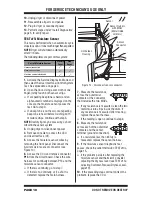
PAGE 16
FOR SERVICE TECHNICIAN’S USE ONLY
DO NOT REMOVE OR DESTROY
If the resistance is OK, the outlet thermistor
is good. Proceed to step 4.
If the thermistor resistance does not agree
with the table, replace the outlet thermistor.
4.
Check P4/P14-3 and P4/P14-6 to
dryer cabinet ground. If either pin indicates
continuity to ground (short), replace wiring
harness; otherwise, proceed to step 5.
5.
If the preceding steps did not correct the
problem, replace the CCU.
Temperature Levels Incorrect –
If no error code
is displayed and the connections to the thermistor
are good, check the exhaust temperature value
at any or all of the temperature levels in question,
using the
“timed dry”
cycle.
1.
Remove load from dryer and disconnect
external vent.
2.
Plug in dryer or reconnect power.
3.
Run a
“timed dry”
cycle of at least 5
minutes in duration. Select high, medium,
low, or extra low.
4.
Using a calibrated temperature probe,
take a temperature measurement in the center
of the exhaust outlet. The correct exhaust
temperatures are as follows:
If the temperature is not reached within
~7 minutes, check voltage level and vent
blockage, and then retest.
If the temperature probe does not agree
with temperature setting, replace the outlet
thermistor.
If the temperature probe confirms the
temperature setting, retest at a different
temperature setting.
TEMPERATURE
SETTING
HEAT TURNS OFF*
°F (°C)
HEAT TURNS ON
°F (°C)
High
155° ± 5° (68° ± 3°)
Medium
140° ± 5° (60° ± 3°)
Low
125° ± 5° (52° ± 3°)
Extra Low
105° ± 5° (41° ± 3°)
EXHAUST TEMPERATURES
10–15° (6–8°)
below the
heat turn off
temperature
5.
If the preceding steps did not correct the
problem, replace the CCU.
Inlet Thermistor
NOTE:
On the electric dryer, the inlet thermistor
is part of the high thermostat assembly (see
Figure 12a, page 14). On the gas dryer, the
inlet thermistor is located at the top of the drum
inlet vent (see Figure 17, page 23).
The CCU monitors the inlet temperature using
the inlet thermistor. The inlet thermistor (along
with the outlet thermistor) is used to detect air
flow, and assists in calculating load size.
1.
Unplug dryer or disconnect power.
2.
Remove console to access the CCU and
User Interface (UI).
3.
Remove connector
P4/P14
from the CCU
and measure the resistance between P4/P14-1
and P4/P14-2 at the connector. The following
tables (electric & gas) give temperatures and
the associated resistance values.
NOTE:
All thermistor resistance measurements
must be made while dryer is unplugged and
connector removed from CCU.
If the resistance is OK, the inlet thermistor
is good. Proceed to step 4.
If the thermistor resistance does not agree
with the table, replace the inlet thermistor.
TEMP.
°F (°C)
RES.
RANGE
k ohms
TEMP.
°F (°C)
RES.
RANGE
k ohms
68° (20°)
61.2–63.7
131° (55°)
14.5–15.3
77° (25°)
49.0–51.0
140° (60°)
12.1–12.8
86° (30°)
39.5–41.1
149° (65°)
10.2–10.7
95° (35°)
32.0–33.3
158° (70°)
8.5–9.0
104° (40°)
26.1–27.2
167° (75°)
7.2–7.6
113° (45°)
21.4–22.3
176° (80°)
6.1–6.5
122° (50°)
17.6–18.5
ELECT - INLET THERMISTOR RESISTANCE
TEMP.
°F (°C)
RES.
RANGE
k ohms
TEMP.
°F (°C)
RES.
RANGE
k ohms
68° (20°)
57.5–67.6
131° (55°)
14.1–15.6
77° (25°)
46.1–53.8
140° (60°)
11.8–12.9
86° (30°)
37.4–43.1
149° (65°)
9.9–10.8
95° (35°)
30.4–34.7
158° (70°)
8.4–9.0
104° (40°)
24.9–28.2
167° (75°)
7.1–7.6
113° (45°)
20.5–23.0
176° (80°)
6.0–6.4
122° (50°)
16.9–18.9
GAS - INLET THERMISTOR RESISTANCE
TEMP.
°F (°C)
RES.
RANGE
k ohms
TEMP.
°F (°C)
RES.
RANGE
k ohms
50° (10°)
19.0–22.0
80° (27°)
8.5–10.5
60° (16°)
14.8–16.8
90° (32°)
6.8–8.8
70° (21°)
11.5–13.5
100° (38°)
5.0–7.0
OUTLET THERMISTOR RESISTANCE
















































